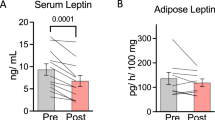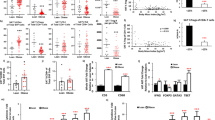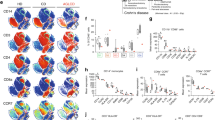Abstract
Nutritional deprivation suppresses immune function1,2,3. The cloning of the obese gene and identification of its protein product leptin4 has provided fundamental insight into the hypothalamic regulation of body weight5,6. Circulating levels of this adipocyte-derived hormone are proportional to fat mass6,7 but may be lowered rapidly by fasting8,9 or increased by inflammatory mediators10,11. The impaired T-cell immunity of mice12,13 now known to be defective in leptin (ob/ob)4 or its receptor (db/db)14,15, has never been explained. Impaired cell-mediated immunity1,2,3 and reduced levels of leptin7 are both features of low body weight in humans. Indeed, malnutrition predisposes to death from infectious diseases16. We report here that leptin has a specific effect on T-lymphocyte responses, differentially regulating the proliferation of naive and memory T cells. Leptin increased Th1 and suppressed Th2 cytokine production. Administration of leptin to mice reversed the immunosuppressive effects of acute starvation. Our findings suggest a new role for leptin in linking nutritional status to cognate cellular immune function, and provide a molecular mechanism to account for the immune dysfunction observed in starvation.
This is a preview of subscription content, access via your institution
Access options
Subscribe to this journal
Receive 51 print issues and online access
$199.00 per year
only $3.90 per issue
Buy this article
- Purchase on Springer Link
- Instant access to full article PDF
Prices may be subject to local taxes which are calculated during checkout





Similar content being viewed by others
References
Chandra, R. K. Nutrition and immunity: Lessons from the past and new insights into the future. Am. J. Clin. Nutr. 53, 1087–1101 (1991).
Cason, J., Ainley, C. C., Wolstencroft, R. A., Norton, K. R. & Thompson, R. P. Cell-mediated immunity in anorexia nervosa. Clin. Exp. Immunol. 64, 370–375 (1986).
Polack, E. et al. Low lymphocyte interferon-gamma production and variable proliferative response in anorexia nervosa patients. J. Clin. Immunol. 13, 445–451 (1993).
Zhang, Y. et al. Positional cloning of the mouse obese gene and its human homologue. Nature 372 425–432 (1994).
Halaas, J. L. et al. Weight-reducing effects of the plasma protein encoded by the obese gene. Science 269, 543–546 (1995).
Friedman, J. M. Leptin, leptin receptors and the control of body weight. Eur. J. Med. Res. 2, 7–13 (1997).
Grinspoon, S. et al. Serum leptin levels in women with anorexia nervosa. J. Clin. Endocrinol. Metab. 81, 3861–3863 (1996).
Boden, G., Chen, X., Mozzoli, M. & Ryan, I. Effect of fasting on serum leptin in normal human subjects. J. Clin. Endocrinol. Metab. 81, 3419–3423 (1996).
Ahima, R. S. et al. Role of leptin in the neuroendocrine response to fasting. Nature 382, 250–252 (1996).
Janik, J. e. et al. Interleukin 1 alpha increases serum leptin concentrations in humans. J. Clin. Endocrinol. Metab. 82, 3084–3086 (1997).
Sarraf, P. et al. Multiple cytokines and acute inflammation raise mouse leptin levels: potential role in inflammatory anorexia. J. Exp. Med. 185, 171–175 (1997).
Fernandes, G., Handwerger, B. S., Yunis, E. J. & Brown, D. M. Immune response in the mutant diabetic C57BL/Ks-db+ mouse. Discrepancies between in vitro and in vivo immunological assays. J. Clin. Invest. 61, 243–250 (1978).
Chandra, R. K. Cell-mediated immunity in genetically obese (C57BL/6J ob/ob) mice. Am. J. Clin. Nutr. 33, 13–16 (1980).
Ghilardi, N. et al. Defective STAT signalling by the leptin receptor in diabetic mice. Proc. Natl Acad. Sci. USA 93, 6231–6235 (1996).
Lee, G. H. et al. Abnormal splicing of the leptin receptor in diabetic mice. Nature 379, 632–635 (1996).
Shears, P. Epidemiology and infection in famine and disasters. Epidemiol. Infect. 107, 241–251 (1991).
Considine, R. V. et al. Serum immunoreactive-leptin concentrations in normal-weight and obese humans. N. Engl. J. Med. 334, 292–295 (1996).
Gotoda, T. et al. Leptin receptor gene variation and obesity: lack of association in a white British male population. Hum. Mol. Genet. 6, 869–876 (1997).
Lombardi, G. et al. Are primary alloresponses truly primary? Int. Immunol. 2, 9–13 (1990).
Abbas, A. K., Murphy, K. M. & Sher, A. Functional diversity of helper T lymphocytes. Nature 383, 787–793 (1996).
Boehm, U., Klamp, T., Groot, M. & Howard, J. C. Cellular responses to interferon-gamma. Annu. Rev. Immunol. 15, 749–795 (1997).
Semnani, R. T., Nutman, T. B., Hochman, P., Shaw, S. & van Seventer, G. A. Costimulation by purified intercellular adhesion molecule 1 and lymphocyte function-associated antigen 3 induces distinct proliferation, cytokine and cell surface antigen profiles in human “naive” and “memory” CD4+ T cells. J. Exp. Med. 180, 2125–2135 (1994).
Besedovsky, H. O. & del Rey, A. Immune-neuro-endocrine interactions: facts and hypotheses. Endocr. Rev. 17, 64–102 (1996).
Young, J. L., Ramage, J. M., Hill-Gaston, J. S. & Beverley, P. C. L. In vitro responses of human CD45RObright and CD45RAbright T cell subsets and their relationship to memory and naive T cells. Eur. J. Immunol. 27, 2383–2389 (1997).
Laufer, T. M., DeKoning, J., Markowitz, J. S., Lo, D. & Glimcher, L. H. Unopposed positive selection and autoreactivity in mice expressing class II MHC only on thymic cortex. Nature 383, 81–85 (1996).
Staite, N. D., Justen, J. M., Sly, L. M., Beaudet, A. L. & Bullard, D. C. Inhibition of delayed-type contact hypersensitivity in mice deficient in both E-selectin and P-selectin. Blood 88, 2973–2979 (1996).
Beak, S. A. et al. Glucagon-like peptide-1 (GLP-1) releases thyrotropin (TSH): characterization of binding sites for GLP-1 on alpha-TSH cells. Endocrinology 137, 4130–4138 (1996).
Acknowledgements
We thank C. Campagnoli, J. G. Chai, A. Di Giacomo, J. Gardiner, G. Lombardi, A.Macrae and L.-Q. Gao for technical assistance and for helpful suggestions and D. Gray, H. Reiser and D. Smith for critically reviewing the manuscript. G.M.L., J.K.H. and R.J.B. are MRC Clinical Training Fellows.
Author information
Authors and Affiliations
Corresponding author
Rights and permissions
About this article
Cite this article
Lord, G., Matarese, G., Howard, J. et al. Leptin modulates the T-cell immune response and reverses starvation-induced immunosuppression. Nature 394, 897–901 (1998). https://doi.org/10.1038/29795
Received:
Accepted:
Issue Date:
DOI: https://doi.org/10.1038/29795
This article is cited by
-
Adipokines in atopic dermatitis: the link between obesity and atopic dermatitis
Lipids in Health and Disease (2024)
-
Relevance and consequence of chronic inflammation for obesity development
Molecular and Cellular Pediatrics (2023)
-
Breast feeding, obesity, and asthma association: clinical and molecular views
Clinical and Molecular Allergy (2023)
-
Genome-wide association study for growth traits in Blanco Orejinegro and Romosinuano cattle
Tropical Animal Health and Production (2023)
Comments
By submitting a comment you agree to abide by our Terms and Community Guidelines. If you find something abusive or that does not comply with our terms or guidelines please flag it as inappropriate.



